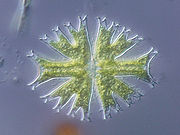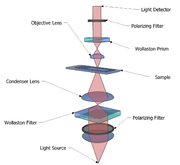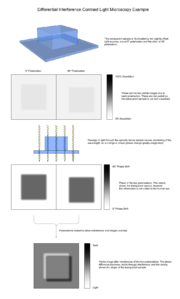
Differential interference contrast microscopy
Encyclopedia

Georges Nomarski
Georges Nomarski was a Polish physicist and optics theoretician. Creator of Nomarski Interference Contrast or differential interference contrast microscopy , the method is widely used to study live biological specimens and unstained tissues.-Biography:Born in Nowy Targ, Nomarski was educated in...
Interference Contrast (NIC) or Nomarski microscopy, is an optical microscopy illumination
Lighting
Lighting or illumination is the deliberate application of light to achieve some practical or aesthetic effect. Lighting includes the use of both artificial light sources such as lamps and light fixtures, as well as natural illumination by capturing daylight...
technique used to enhance the contrast
Contrast (vision)
Contrast is the difference in visual properties that makes an object distinguishable from other objects and the background. In visual perception of the real world, contrast is determined by the difference in the color and brightness of the object and other objects within the same field of view...
in unstained, transparent samples. DIC works on the principle of interferometry to gain information about the optical path length
Optical path length
In optics, optical path length or optical distance is the product of the geometric length of the path light follows through the system, and the index of refraction of the medium through which it propagates. A difference in optical path length between two paths is often called the optical path...
of the sample, to see otherwise invisible features. A relatively complex lighting scheme produces an image with the object appearing black to white on a grey background. This image is similar to that obtained by phase contrast microscopy but without the bright diffraction halo.
DIC works by separating a polarised light source into two orthogonally polarized mutually coherent parts which are spatially displaced (sheared) at the sample plane, and recombined before observation. The interference of the two parts at recombination is sensitive to their optical path difference (i.e. the product of refractive index
Refractive index
In optics the refractive index or index of refraction of a substance or medium is a measure of the speed of light in that medium. It is expressed as a ratio of the speed of light in vacuum relative to that in the considered medium....
and geometric path length). Adding an adjustable offset phase determining the interference at zero optical path difference in the sample, the contrast is proportional to the path length gradient along the shear direction, giving the appearance of a three-dimensional physical relief corresponding to the variation of optical density of the sample, emphasising lines and edges though not providing a topographically accurate image.
The light path

Microscope
A microscope is an instrument used to see objects that are too small for the naked eye. The science of investigating small objects using such an instrument is called microscopy...
and is polarised at 45°.
- Polarised light is required for the technique to work.
2. The polarised light enters the first Nomarski-modified
Nomarski prism
A Nomarski prism is a modification of the Wollaston prism that is used in differential interference contrast microscopy. It is named after its inventor, Polish physicist Georges Nomarski. Like the Wollaston prism, the Nomarski prism consists of two birefringent crystal wedges cemented together at...
Wollaston prism
Wollaston prism
A Wollaston prism is an optical device, invented by William Hyde Wollaston, that manipulates polarized light. It separates randomly polarized or unpolarized light into two orthogonal linearly polarized outgoing beams....
and is separated into two rays polarised at 90° to each other, the sampling and reference rays.
- Wollaston prisms are a type of prism made of two layers of a crystalline substance, such as quartz, which, due to the variation of refractive index depending on the polarisation of the light, splits the light according to its polarisation. The Nomarski prismNomarski prismA Nomarski prism is a modification of the Wollaston prism that is used in differential interference contrast microscopy. It is named after its inventor, Polish physicist Georges Nomarski. Like the Wollaston prism, the Nomarski prism consists of two birefringent crystal wedges cemented together at...
causes the two rays to come to a focal point outside the body of the prism, and so allows greater flexibility when setting up the microscope, as the prism can be actively focused.
3. The two rays are focused by the condenser for passage through the sample. These two rays are focused so they will pass through two adjacent points in the sample, around 0.2 μm apart.
- The sample is effectively illuminated by two coherentCoherence (physics)In physics, coherence is a property of waves that enables stationary interference. More generally, coherence describes all properties of the correlation between physical quantities of a wave....
light sources, one with 0° polarisation and the other with 90° polarisation. These two illuminations are, however, not quite aligned, with one lying slightly offset with respect to the other.

Phase (waves)
Phase in waves is the fraction of a wave cycle which has elapsed relative to an arbitrary point.-Formula:The phase of an oscillation or wave refers to a sinusoidal function such as the following:...
of one ray relative to the other due to the delay experienced by the wave in the more optically dense material.
- The passage of many pairs of rays through pairs of adjacent points in the sample (and their absorbance, refractionRefractionRefraction is the change in direction of a wave due to a change in its speed. It is essentially a surface phenomenon . The phenomenon is mainly in governance to the law of conservation of energy. The proper explanation would be that due to change of medium, the phase velocity of the wave is changed...
and scattering by the sample) means an image of the sample will now be carried by both the 0° and 90° polarised light. These, if looked at individually, would be bright fieldBright field microscopyBright field microscopy is the simplest of all the optical microscopy illumination techniques. Sample illumination is transmitted white light and contrast in the sample is caused by absorbance of some of the transmitted light in dense areas of the sample...
images of the sample, slightly offset from each other. The light also carries information about the image invisible to the human eye, the phase of the light. This is vital later. The different polarisations prevent interference between these two images at this point.
5. The rays travel through the objective lens and are focused for the second Nomarski-modified Wollaston prism.
6. The second prism
Nomarski prism
A Nomarski prism is a modification of the Wollaston prism that is used in differential interference contrast microscopy. It is named after its inventor, Polish physicist Georges Nomarski. Like the Wollaston prism, the Nomarski prism consists of two birefringent crystal wedges cemented together at...
recombines the two rays into one polarised at 135°. The combination of the rays leads to interference, brightening or darkening the image at that point according to the optical path difference.
- This prism overlays the two bright field images and aligns their polarisations so they can interfere. However, the images do not quite line up because of the offset in illumination - this means that instead of interference occurring between 2 rays of light that passed through the same point in the specimen, interference occurs between rays of light that went through adjacent points which therefore have a slightly different phase. Because the difference in phase is due to the difference in optical path length, this recombination of light causes "optical differentiationDifferentiation (sociology)Differentiation is a term in system theory From the viewpoint of this theory, the principal feature of modern society is the increased process of system differentiation as a way of dealing with the complexity of its environment. This is accomplished through the creation of subsystems in an effort...
" of the optical path length, generating the image seen.
Image

As explained above, the image is generated from two identical bright field images being overlaid slightly offset from each other (typically around 0.2 μm), and the subsequent interference due to phase difference converting changes in phase (and so optical path length) to a visible change in darkness. This interference may be either constructive or destructive, giving rise to the characteristic appearance of three dimensions.
The typical phase difference giving rise to the interference is very small, very rarely being larger than 90° (a quarter of the wavelength). This is due to the similarity of refractive index of most samples and the media they are in: for example, a cell in water only has a refractive index difference of around 0.05. This small phase difference is important for the correct function of DIC, since if the phase difference at the joint between two substances is too large then the phase difference could reach 180° (half a wavelength), resulting in complete destructive interference and an anomalous dark region; if the phase difference reached 360° (a full wavelength), it would produce complete constructive interference, creating an anomalous bright region.
The image can be approximated (neglecting refraction and absorption due to the sample and the resolution limit of beam separation) as the differential of optical path length with respect to position across the sample along the shear, and so the differential of the refractive index (optical density) of the sample.
The contrast can be adjusted using the offset phase, either by translating the objective Normarski prism, or by a lambda/4 waveplate between polarizer and the condenser Normarski prism (De-Senarmont Compensation). The resulting contrast is going from dark-field for zero phase offset (intensity proportional to the square of the shear differential), to the typical relief seen for phase of ~5–90 degrees, to optical staining at 360 degrees, where the extinguished wavelength shifts with the phase differential.
Advantages and disadvantages

The main limitation of DIC is its requirement for a transparent sample of fairly similar refractive index to its surroundings. DIC is unsuitable (in biology) for thick samples, such as tissue slices, and highly pigmented cells. DIC is also unsuitable for most non biological uses because of its dependence on polarisation, which many physical samples would affect.
One non-biological area where DIC is useful is in the analysis of planar silicon semiconductor processing. The thin (typically 100-1000 nm) films in silicon processing are often mostly transparent to visible light (e.g., silicon dioxide, silicon nitride and polycrystalline silicon), and defects in them or contamination lying on top of them become more visible. This also enables the determination of whether a feature is a pit in the substrate material or a blob of foreign material on top. Etched crystalline features gain a particularly striking appearance under DIC.
Image quality, when used under suitable conditions, is outstanding in resolution and almost entirely free of artifacts unlike phase contrast. However analysis of DIC images must always take into account the orientation of the Wollaston prisms and the apparent lighting direction, as features parallel to this will not be visible. This is, however, easily overcome by simply rotating the sample and observing changes in the image.
See also
- Classical interference microscopyClassical interference microscopyClassical interference microscopy uses two separate light beams with much greater lateral separation than that used in phase contrast microscopy or in differential interference microscopy ....
- MicroscopyMicroscopyMicroscopy is the technical field of using microscopes to view samples and objects that cannot be seen with the unaided eye...
- Nomarski prismNomarski prismA Nomarski prism is a modification of the Wollaston prism that is used in differential interference contrast microscopy. It is named after its inventor, Polish physicist Georges Nomarski. Like the Wollaston prism, the Nomarski prism consists of two birefringent crystal wedges cemented together at...
- Nanovid microscopyNanovid microscopyNanovid microscopy, from “nanometer video-enhanced microscopy”, is a microscopic technique aimed at visualizing colloidal gold particles of 20-40 nm diameter as dynamic markers at the light microscopic level...
- Phase contrast microscopyPhase contrast microscopyPhase contrast microscopy is an optical microscopy illumination technique of great importance to biologists in which small phase shifts in the light passing through a transparent specimen are converted into amplitude or contrast changes in the image.A phase contrast microscope does not require...

